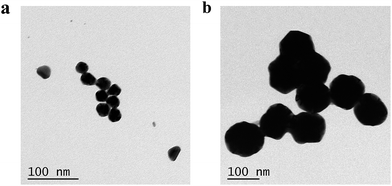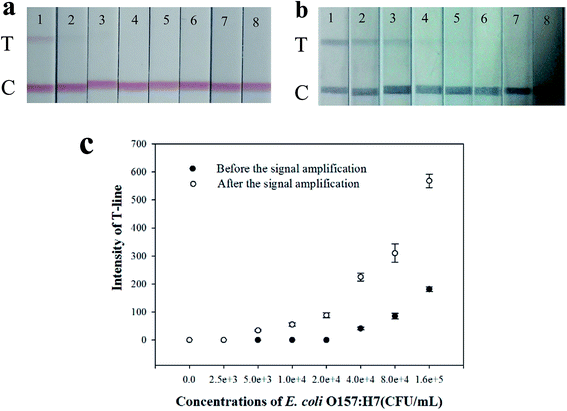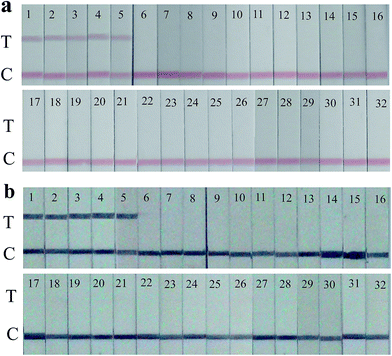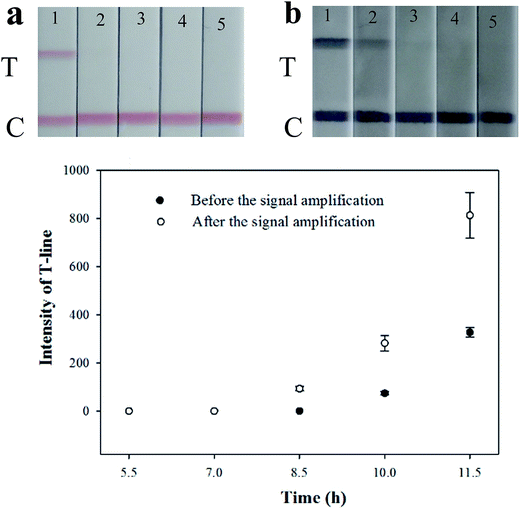Development of colloidal gold immunochromatographic signal-amplifying system for ultrasensitive detection of Escherichia coli O157:H7 in milk
Jing-Yun Wanga,
Ming-Hui Chena,
Zhi-Chao Shengb,
Dao-Feng Liua,
Song-Song Wua and
Wei-Hua Lai*a
aState Key Laboratory of Food Science and Technology, Nanchang University, 235 Nanjing East Road, Nanchang, 330047, China. E-mail: talktolaiwh@163.com; Fax: +86-791-88157619; Tel: +86-791-83969526
bLianyungang Entry-Exit Inspection and Quarantine Bureau, Lianyungang, 222000, China
First published on 14th July 2015
Abstract
A colloidal gold immunochromatographic signal-amplifying test strip with a sandwich format was successfully developed to detect Escherichia coli O157:H7. The detection signal was improved by addition of enhancers (HAuCl4 and NH2OH·HCl) to the nitrocellulose membrane of a conventional immunochromatographic strip. The detection sensitivities of the test strip before and after signal amplification were 4 × 104 and 5 × 103 CFU mL−1, respectively, as determined by a colloidal gold strip reader. An 8-fold increase in sensitivity after signal amplification was accomplished within 20 min. No cross-reactivity with 27 non-target strains was observed, and the time for detecting E. coli O157:H7 in spiked milk samples was shortened by 1.5 h. The colloidal gold immunochromatographic signal-amplifying test strip thus provides a novel method for determining E. coli O157:H7 and is rapid, sensitive, convenient, and suitable for on-site detection.
1. Introduction
Escherichia coli O157:H7 is a very harmful food-borne pathogen that can cause disease with a minimum of 10 colony-forming units (CFU) of living bacteria.1 The most common clinical symptoms of E. coli O157:H7 infection include diarrhea, hemorrhagic colitis, hemolytic uremic syndrome, and thrombotic thrombocytopenic purpura.2 The traditional separation–identification method, which involves pre-enrichment, selective enrichment, isolated culture, biochemical identification, and serological identification, is used as the “gold standard” for detecting E. coli O157:H7 in food samples. However, conventional detection methods require 5–7 days to identify the target bacterium, and isolation and culture are both time-consuming and laborious. To address these issues, several methods based on nucleic acid detection3 have been developed. Enzyme-linked immunosorbent assay (ELISA),4 biosensing,5 and electrochemical strategies,6 for example, have been extensively investigated for their applicability in E. coli O157:H7 detection. However, these methods require technical expertise, laborious procedures, and expensive instruments. Such drawbacks further limit these methods from application in on-site detection. Therefore, it is extremely important to develop a rapid, sensitive and simple method for detecting E. coli O157:H7 in food samples.Colloidal gold immunochromatographic assays present four advantages, including a user-friendly format, a short period of time required to acquire test results, long-term stability over a wide range of climates, and relatively inexpensive production. However, colloidal gold immunochromatographic assays show serious limitation when high sensitivity is necessary.7,8
Novel methods of improving the sensitivity of colloidal gold immunochromatographic strip have been recently developed. Mei et al.,9 for example, detected bisphenol A by adopting a double gold probe to improve the sensitivity of the test strip; in this study, the original colloidal gold signal was strengthened by an auxiliary composed of large-diameter gold nanoparticles. The sensitivity of this method improved by 10-fold compared with the original probe. Yang et al.10 detected abrin-a by a silver enhancement technology that can generate Au/Ag-core–shell nanoparticles by using colloidal gold to catalyze the AgNO3 and corresponding reduction agents; this technique resulted in 100-fold enhancement of the test strip sensitivity. Li et al.11 added enhancers (i.e., HAuCl4 and NH2OH·HCl) to a colloidal gold immunochromatographic strip to improve its sensitivity to Avian influenza and Newcastle disease viruses by 100-fold.
In this study, a colloidal gold immunochromatographic signal-amplifying test strip was firstly developed to detect E. coli O157:H7 (Fig. 1). This technology improves signals by using colloidal gold to catalyze the reaction between HAuCl4 and NH2OH·HCl to form larger gold nanoparticles. Different from Li's method,11 CG-mAb is added into ELISA wells to incubate with the sample for an adequate amount of time instead of sprayed on a conjugate pad to react with the antigen instantaneously, and the parameters of the test strip were also optimized to eliminate false-positive results after signal amplification.
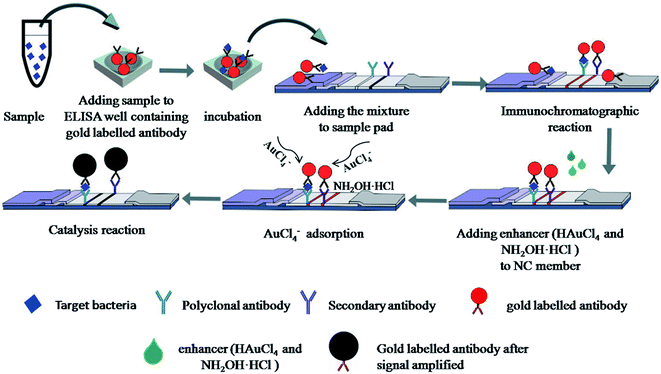 | ||
| Fig. 1 Overall process of the colloidal gold immunochromatographic signal-amplifying assay for detecting E. coli O157:H7. | ||
2. Experimental
2.1 Materials
2.2 Preparation of colloidal gold
Colloidal gold solution was prepared by reduction of HAuCl4·3H2O with trisodium citrate.12 Briefly, 1.2 mL of a 1% (w/v) stock solution of trisodium citrate was added to 100 mL of boiling 0.01% gold chloride trihydrate solution under constant stirring. When the color of the mixture had turned red, the mixture was boiled for another 5 min. The colloidal gold solution obtained was supplemented with 0.01% (w/v) sodium azide and stored at 4 °C until further use. The particle size and dispersity of the solution were determined by transmission electron microscopy.2.3 Preparation of colloidal gold probe
The colloidal gold solution was adjusted to pH 8.5 with 0.2 M K2CO3. Under gentle stirring, 1 mL of anti-E. coli O157:H7 monoclonal antibody solution was added dropwise to the colloidal gold solution to achieve a final concentration of 0.2 mg mL−1. Agitation for 60 min followed. The conjugate (CG-mAb) was then blocked with 1 mL of 10% (w/v) BSA solution. After 30 min, the mixture was centrifuged at 7200 rpm for 30 min to remove unconjugated antibodies. The precipitate was re-suspended with 1 mL of dilution buffer, and the prepared CG-mAb was dried on ELISA plates for 2 h at 30 °C until use.2.4 Preparation of immunochromatographic test strips
The sample pad was treated with 0.1 M Tris–HCl (pH 8.5) solution containing 1% BSA, 0.5% Tween-20, and 0.02% NaN3 and then dried at 60 °C for 2 h. The conjugated pad was soaked in 0.1 M Tris–HCl (pH 8.5) solution containing 0.1% Tween-20 and 0.02% NaN3 for 24 h and dried at 60 °C for 2 h. Goat anti-E. coli O157:H7 polyclonal antibody (1.2 mg mL−1) and donkey anti-mouse IgG (1.2 mg mL−1) were respectively spotted onto the test and control lines on the nitrocellulose membrane, and the dispensed volume was 0.75 μL cm−1. The sample pad, conjugated pad, nitrocellulose membrane, and absorption pad were assembled as a strip.2.5 Optimization of test strip parameters
The colloidal gold immunochromatographic strip was optimized by varying the volume of the CG-mAb in the ELISA wells (i.e., 4, 5, 6 μL), blocking agent of CG-mAb (i.e., 5% BSA, 10% BSA, 10% casein), and blocking agent of the nitrocellulose membrane (i.e., 0.5% BSA, 1% BSA, 1% casein). All experiments were performed in triplicate.2.6 Detection by the conventional colloidal gold immunochromatographic strip
Exactly 100 μL of sample were pipette into the ELISA well which was added with CG-mAb compound and incubated for 3 min. The mixture was transmitted to the strip. After 10 min, the strip was detected with a portable strip reader.2.7 Detection by the colloidal gold immunochromatographic signal-amplifying strip
Upon completion of the conventional immunochromatographic reaction ended, the strip was washed three times with deionized water. HAuCl4 (1%) and NH2OH·HCl (10 mM) were mixed (v/v, 1![[thin space (1/6-em)]](https://www.rsc.org/images/entities/char_2009.gif) :
:![[thin space (1/6-em)]](https://www.rsc.org/images/entities/char_2009.gif) 5) as an enhancer, and 50 μL of the freshly made mixture was added to the nitrocellulose membrane. After 5 min, the strip was detected with the portable strip reader.
5) as an enhancer, and 50 μL of the freshly made mixture was added to the nitrocellulose membrane. After 5 min, the strip was detected with the portable strip reader.
2.8 Characterization of colloidal gold before and after signal amplification
The properties of colloidal gold before and after signal amplification were characterized by transmission electron microscopy (TEM) and UV-vis spectrum. The colloidal gold before signal amplification was prepared in Section 2.2. The colloidal gold after signal amplification was obtained in 1.5 mL centrifuge tube by simulating the proportion of colloidal gold and enhancer on nitrocellulose membrane.2.9 Sensitivity of the test strip
E. coli O157:H7 cultures at concentrations of 0 (negative control), 2.5 × 103, 5 × 103, 1 × 104, 2 × 104, 4 × 104, 8 × 104, and 1.6 × 105 CFU mL−1 were prepared with sterile 0.01 M PBS (pH 8.5). The sensitivity of the test strip before and after signal amplification was evaluated by the prepared E. coli O157:H7 cultures. The detection method was the same as Sections 2.6 and 2.7. All experiments were performed in triplicate.2.10 Cross-reactivity of the test strip
Five E. coli O157:H7 and 27 non-E. coli O157:H7 strains at a concentration of 107 CFU mL−1 were tested using conventional and proposed signal-amplifying strips to evaluate the specificity of two methods.2.11 Detection of food sample by test strip
Twenty-five grams of reduced fat milk that had been confirmed to be free of E. coli O157:H7 was mixed with 225 mL of sterilized Luria-Bertani (LB) medium and E. coli O157:H7 (1–10 CFU). The mixture was inoculated at 37 °C with gentle shaking at 170 rpm, and colony counting was performed at the same time to validate the initial number of inoculated E. coli O157:H7.13 After 4 h, 1 mL of food sample was transferred into a 2 mL sterile plastic culture tube with a screw cap every 1.5 h; this process lasted for 7.5 h. The samples were tested by conventional and proposed signal amplifying test strip.3. Results and discussion
3.1 Determination of test results
The test system is based on a sandwich-format immunoassay. The sample was mixed with CG-Ab conjugate in an ELISA plate. The mixture was then added to the sample pad and allowed to migrate by capillary action to the absorbent pad. If the concentration of E. coli O157:H7 in the sample is at the limit of detection or higher, the E. coli O157:H7–CG-Ab conjugate will be captured by the goat anti-E. coli O157:H7 polyclonal antibody (test line). An enhancer was used to amplify the signal. A red (or black) line appearing in the test region indicates a positive result. If the concentration of E. coli O157:H7 in the sample is below the limit of detection level, no red (or black) line will be observed in the test region, indicating a negative result. The CG-Ab conjugate must bind to donkey anti-mouse IgG (control line) and form a red (or black) line regardless of the presence of E. coli O157:H7.3.2 Characterization of colloidal gold
In this research, colloidal gold was used as a marker of the immunochromatographic assay. As shown in Fig. 2a and b, the average diameter of colloidal gold before signal amplification was 30 nm. After addition of the enhancer, the colloidal gold catalyzed a reaction between HAuCl4 and NH2OH·HCl to form larger gold nanoparticles.14 Thus, the average diameter of colloidal gold increased to 120 nm. As seen in Fig. 3, the peak of UV-vis spectrum of colloidal gold obviously red shifted from 529 nm to 547 nm after signal amplification, thereby improving the sensitivity.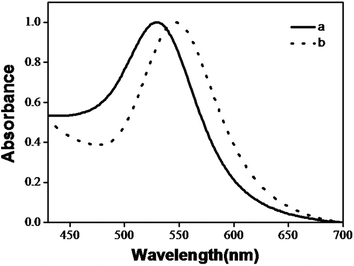 | ||
Fig. 3 The UV-vis spectra of colloidal gold (a) before and (b) after signal amplification. HAuCl4 (1%): NH2OH·HCl (10 mM) = 1![[thin space (1/6-em)]](https://www.rsc.org/images/entities/char_2009.gif) : :![[thin space (1/6-em)]](https://www.rsc.org/images/entities/char_2009.gif) 5 (v/v). 5 (v/v). | ||
3.3 Optimization of test strip parameters
False-positive results are a serious problem in research on signal-amplifying test strips. In this study, an orthogonal L9 (3)3 test design15 were performed to optimize the parameters of the signal-amplifying system and eliminate non-specific binding of antibody molecules and gold nanoparticles in the test region. Table 1 revealed that the optimal conditions of strip detection were as follows: volume of CG-mAb in the ELISA well, 4 μL; blocking agent of CG-mAb, 10% BSA; and blocking agent of the nitrocellulose membrane, 1% casein. Only with the optimal conditions, the signal amplification test strip had negative result after adding negative sample.| No. | The volume of the CG-mAb (μL) | Blocking agent of CG-mAb | Blocking agent of NC membrane | Result of negative sample |
|---|---|---|---|---|
| a Note: “−” stands for negative, “+” stands for positive. | ||||
| 1 | 4 | 5% BSA | 0.5% BSA | + |
| 2 | 4 | 10% BSA | 1% casein | − |
| 3 | 4 | 10% casein | 1% BSA | + |
| 4 | 5 | 5% BSA | 1% casein | + |
| 5 | 5 | 10% BSA | 1% BSA | + |
| 6 | 5 | 10% casein | 0.5% BSA | + |
| 7 | 6 | 5% BSA | 1% BSA | + |
| 8 | 6 | 10% BSA | 0.5% BSA | + |
| 9 | 6 | 10% casein | 1% casein | + |
3.4 Sensitivity analysis of the test strip
Under optimal conditions, solutions of E. coli O157:H7 dissolved in PBS at levels of 0, 2.5 × 103, 5 × 103, 1 × 104, 2 × 104, 4 × 104, 8 × 104, and 1.6 × 105 CFU mL−1 were prepared and assayed by the test strip. Fig. 4a and c demonstrate that the color intensity of the test line is proportional to the concentration of E. coli O157:H7 in the range of 4 × 104 to 1.6 × 105 CFU mL−1 before test strip signal amplification; here, the detection limit determined by the naked eye and strip reader was 4 × 104 CFU mL−1. As shown in Fig. 4b and c, after addition of enhancer to the nitrocellulose membrane, the intensity of the test line significantly improved as the concentration of E. coli O157:H7 increased. The detection limit of E. coli O157:H7 improved to 5 × 103 CFU mL−1, as determined by the naked eye and strip reader. This result reveals an 8-fold increase in sensitivity. In the negative control, no colloidal gold probe was bound to the goat anti-E. coli O157:H7 polyclonal antibody in the test line. Use of the enhancer (i.e., HAuCl4 and NH2OH·HCl) significantly improved the color intensity of the control and test lines. Recently, some scholars were also studying how to improve the sensitivity of immunochromatographic strip, Wu et al.16 used two different aptamers for detection of E. coli O157:H7. One of the aptamers was used for magnetic bead enrichment, and the other was used as a signal reporter for this pathogen by a lateral flow biosensor. Comparing with the method specially for detection of E. coli O157:H7, our method in this paper could improve sensitivity for all immunochromatographic strips using colloidal gold as marker.3.5 Cross-reactivity analysis of the test strip
To examine the specificity of the immunochromatographic assay, cross-reactivity during assay development must be tested because many antigenic sites of the bacterial cell surface, e.g., lipopolysaccharides and various surface antigens (e.g., K-, O-, and H-antigens) are analogous to those of other genera and species.17 Twenty seven non-target strains of common pathogenic bacteria in food samples were used to evaluate the specificity of E. coli O157:H7 as described in Section 2.1. No red (or black) band appeared in the test region before and after test strip signal amplification even when each bacterium was administered at a high concentration (107 CFU mL−1). This finding indicates that the test strip has high specificity (Fig. 5).3.6 Detection of spiked E. coli O157:H7 milk
The concentration of E. coli O157:H7 inoculated into milk was determined at 6 CFU by colony counting. After 4 h of incubation, the milk sample was detected by using the test strips every 1.5 h. As shown in Fig. 6a and c, the time required to detect E. coli O157:H7 in the spiked milk sample was 10 h when using the conventional test strip; thus, use of this type of strip is time-consuming. After signal amplification, the time required to detect E. coli O157:H7 in the spiked milk sample was 8.5 h; this time is 1.5 h less than that required by the conventional test strip. The color intensity of the test line also significantly improved, as can be seen in Fig. 6b and c.4. Conclusions
A colloidal gold immunochromatographic signal-amplifying test strip was developed to achieve sensitive and on-site detection of E. coli O157:H7 in less than 20 min. An 8-fold improvement in sensitivity was achieved after test strip signal amplification. These characteristics demonstrated that the proposed signal-amplifying test strip was an ideal candidate for rapid screening of E. coli O157:H7 in food samples and it also provided a method of improving sensitivity for all immunochromatographic strips using colloidal gold as marker.Acknowledgements
We are grateful to the Research Program of State Key Laboratory of Food Science and Technology, Nanchang University (Project No. SKLF-ZZB-201307), earmarked fund for Jiangxi Agriculture Research System (JXARS-03), and the Nanchang Technological Program (2012-CYH-DW-SP-001) for financial support.References
- W. A. Ferens and C. J. Hovde, Foodborne Pathog. Dis., 2011, 8, 465–487 CrossRef PubMed.
- H. Pennington, Lancet, 2010, 376, 1428–1435 CrossRef CAS.
- L. J. Wang, P. Li, Z. H. Zhang, Q. Chen, Z. P. Aguilar, H. Y. Xu, L. Yang, F. Xu, W. H. Lai, Y. H. Xiong and H. Wei, Food Control, 2014, 36, 119–125 CrossRef CAS PubMed.
- Y. L. Bai, W. C. Huang and S. T. Yang, Biotechnol. Bioeng., 2007, 98, 328–339 CrossRef CAS PubMed.
- A. D. Chowdhury, A. De, C. R. Chaudhuri, K. Bandyopadhyay and P. Sen, Sens. Actuators, B, 2012, 171, 916–923 CrossRef PubMed.
- J. P. Wang and S. T. Yau, Anal. Methods, 2014, 6, 5387–5391 RSC.
- T. Peng, W. C. Yang, W. H. Lai, Y. H. Xiong, H. Wei and J. S. Zhang, Anal. Methods, 2014, 6, 7394–7398 RSC.
- Q. Y. Xie, Y. H. Wu, Q. R. Xiong, H. Y. Xu, Y. H. Xiong and K. Liu, Biosens. Bioelectron., 2014, 54, 262–265 CrossRef CAS PubMed.
- Z. L. Mei, W. Qu, Y. Deng, H. Q. Chu, J. X. Cao, F. Xue and L. Zhang, Biosens. Bioelectron., 2013, 49, 457–461 CrossRef CAS PubMed.
- W. Yang, X. B. Li, G. W. Liu, B. B. Zhang and Y. Zhang, Biosens. Bioelectron., 2011, 26, 3710–3713 CrossRef CAS PubMed.
- J. F. Li, M. Q. Zou, Y. Chen, Q. Xue, F. Zhang and B. B. Li, Anal. Chim. Acta, 2013, 782, 54–58 CrossRef CAS PubMed.
- C. H. Li, W. Luo, H. Y. Xu, Q. Zhang, H. Xu and Z. P. Aguilar, Food Control, 2013, 34, 725–732 CrossRef CAS PubMed.
- Y. Arakawa, T. Sawada, K. Takatori, K. I. Lee and Y. HaraKudo, Biocontrol Sci., 2011, 16, 159–164 CrossRef CAS.
- Z. Ma and S. F. Sui, Angew. Chem., Int. Ed., 2002, 41, 2176–2179 CrossRef CAS.
- X. L. Chen, H. Y. Xu, W. H. Lai, Y. Chen, X. H. Yang and Y. H. Xiong, Food Addit. Contam., Part A, 2012, 29, 383–391 CAS.
- W. Wu, S. M. Zhao, Y. P. Mao, Z. Y. Fang, X. W. Lu and L. W. Zeng, Anal. Chim. Acta, 2015, 861, 62–68 CrossRef CAS PubMed.
- I. Cho and J. Irudayaraj, Int. J. Food Microbiol., 2013, 164, 70–75 CrossRef CAS PubMed.
| This journal is © The Royal Society of Chemistry 2015 |

